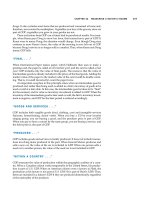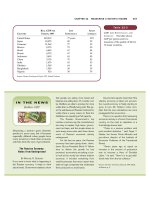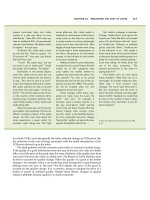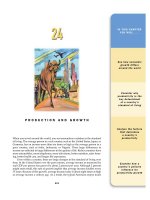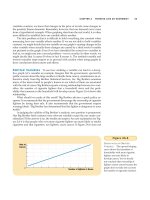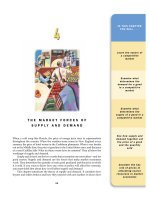Ten Principles of Economics - Part 2
Bạn đang xem bản rút gọn của tài liệu. Xem và tải ngay bản đầy đủ của tài liệu tại đây (271.85 KB, 10 trang )
CHAPTER 1 TEN PRINCIPLES OF ECONOMICS 13
In the 1980s and 1990s, for example, much debate in the United States centered
on the government’s budget deficit—the excess of government spending over gov-
ernment revenue. As we will see, concern over the budget deficit was based
largely on its adverse impact on productivity. When the government needs to
finance a budget deficit, it does so by borrowing in financial markets, much as a
student might borrow to finance a college education or a firm might borrow to
finance a new factory. As the government borrows to finance its deficit, therefore,
it reduces the quantity of funds available for other borrowers. The budget deficit
thereby reduces investment both in human capital (the student’s education) and
physical capital (the firm’s factory). Because lower investment today means lower
productivity in the future, government budget deficits are generally thought to de-
press growth in living standards.
PRINCIPLE #9: PRICES RISE WHEN THE
GOVERNMENT PRINTS TOO MUCH MONEY
In Germany in January 1921, a daily newspaper cost 0.30 marks. Less than two
years later, in November 1922, the same newspaper cost 70,000,000 marks. All
other prices in the economy rose by similar amounts. This episode is one of his-
tory’s most spectacular examples of inflation, an increase in the overall level of
prices in the economy.
Although the United States has never experienced inflation even close to that
in Germany in the 1920s, inflation has at times been an economic problem. During
the 1970s, for instance, the overall level of prices more than doubled, and President
Gerald Ford called inflation “public enemy number one.” By contrast, inflation in
the 1990s was about 3 percent per year; at this rate it would take more than
inflation
an increase in the overall level of
prices in the economy
“Well it may have been 68 cents when you got in line, but it’s 74 cents now!”
14 PART ONE INTRODUCTION
20 years for prices to double. Because high inflation imposes various costs on soci-
ety, keeping inflation at a low level is a goal of economic policymakers around the
world.
What causes inflation? In almost all cases of large or persistent inflation, the
culprit turns out to be the same—growth in the quantity of money. When a gov-
ernment creates large quantities of the nation’s money, the value of the money
falls. In Germany in the early 1920s, when prices were on average tripling every
month, the quantity of money was also tripling every month. Although less dra-
matic, the economic history of the United States points to a similar conclusion: The
high inflation of the 1970s was associated with rapid growth in the quantity of
money, and the low inflation of the 1990s was associated with slow growth in the
quantity of money.
PRINCIPLE #10: SOCIETY FACES A SHORT-RUN TRADEOFF
BETWEEN INFLATION AND UNEMPLOYMENT
If inflation is so easy to explain, why do policymakers sometimes have trouble rid-
ding the economy of it? One reason is that reducing inflation is often thought to
cause a temporary rise in unemployment. The curve that illustrates this tradeoff
between inflation and unemployment is called the Phillips curve, after the econo-
mist who first examined this relationship.
The Phillips curve remains a controversial topic among economists, but most
economists today accept the idea that there is a short-run tradeoff between infla-
tion and unemployment. This simply means that, over a period of a year or two,
many economic policies push inflation and unemployment in opposite directions.
Policymakers face this tradeoff regardless of whether inflation and unemployment
both start out at high levels (as they were in the early 1980s), at low levels (as they
were in the late 1990s), or someplace in between.
Why do we face this short-run tradeoff? According to a common explanation,
it arises because some prices are slow to adjust. Suppose, for example, that the
government reduces the quantity of money in the economy. In the long run, the
only result of this policy change will be a fall in the overall level of prices. Yet not
all prices will adjust immediately. It may take several years before all firms issue
new catalogs, all unions make wage concessions, and all restaurants print new
menus. That is, prices are said to be sticky in the short run.
Because prices are sticky, various types of government policy have short-run
effects that differ from their long-run effects. When the government reduces the
quantity of money, for instance, it reduces the amount that people spend. Lower
spending, together with prices that are stuck too high, reduces the quantity of
goods and services that firms sell. Lower sales, in turn, cause firms to lay off work-
ers. Thus, the reduction in the quantity of money raises unemployment temporar-
ily until prices have fully adjusted to the change.
The tradeoff between inflation and unemployment is only temporary, but it
can last for several years. The Phillips curve is, therefore, crucial for understand-
ing many developments in the economy. In particular, policymakers can exploit
this tradeoff using various policy instruments. By changing the amount that the
government spends, the amount it taxes, and the amount of money it prints,
policymakers can, in the short run, influence the combination of inflation and
unemployment that the economy experiences. Because these instruments of
Phillips curve
a curve that shows the short-run
tradeoff between inflation and
unemployment
CHAPTER 1 TEN PRINCIPLES OF ECONOMICS 15
monetary and fiscal policy are potentially so powerful, how policymakers should
use these instruments to control the economy, if at all, is a subject of continuing
debate.
QUICK QUIZ: List and briefly explain the three principles that describe
how the economy as a whole works.
CONCLUSION
You now have a taste of what economics is all about. In the coming chapters we
will develop many specific insights about people, markets, and economies. Mas-
tering these insights will take some effort, but it is not an overwhelming task. The
field of economics is based on a few basic ideas that can be applied in many dif-
ferent situations.
Throughout this book we will refer back to the Ten Principles of Economics
highlighted in this chapter and summarized in Table 1-1. Whenever we do so,
a building-blocks icon will be displayed in the margin, as it is now. But even
when that icon is absent, you should keep these building blocks in mind. Even the
most sophisticated economic analysis is built using the ten principles introduced
here.
Table 1-1
T
EN
P
RINCIPLES OF
E
CONOMICS
H
OW
P
EOPLE
#1: People Face Tradeoffs
M
AKE
D
ECISIONS
#2: The Cost of Something Is What You Give Up to
Get It
#3: Rational People Think at the Margin
#4: People Respond to Incentives
H
OW
P
EOPLE
I
NTERACT
#5: Trade Can Make Everyone Better Off
#6: Markets Are Usually a Good Way to Organize
Economic Activity
#7: Governments Can Sometimes Improve Market
Outcomes
H
OW THE
E
CONOMY
#8: A Country’s Standard of Living Depends on Its
AS A
W
HOLE
W
ORKS
Ability to Produce Goods and Services
#9: Prices Rise When the Government Prints Too
Much Money
#10: Society Faces a Short-Run Tradeoff between
Inflation and Unemployment
16 PART ONE INTRODUCTION
◆ The fundamental lessons about individual
decisionmaking are that people face tradeoffs among
alternative goals, that the cost of any action is measured
in terms of forgone opportunities, that rational people
make decisions by comparing marginal costs and
marginal benefits, and that people change their behavior
in response to the incentives they face.
◆ The fundamental lessons about interactions among
people are that trade can be mutually beneficial, that
markets are usually a good way of coordinating trade
among people, and that the government can potentially
improve market outcomes if there is some market
failure or if the market outcome is inequitable.
◆ The fundamental lessons about the economy as a whole
are that productivity is the ultimate source of living
standards, that money growth is the ultimate source of
inflation, and that society faces a short-run tradeoff
between inflation and unemployment.
Summary
scarcity, p. 4
economics, p. 4
efficiency, p. 5
equity, p. 5
opportunity cost, p. 6
marginal changes, p. 6
market economy, p. 9
market failure, p. 11
externality, p. 11
market power, p. 11
productivity, p. 12
inflation, p. 13
Phillips curve, p. 14
Key Concepts
1. Give three examples of important tradeoffs that you face
in your life.
2. What is the opportunity cost of seeing a movie?
3. Water is necessary for life. Is the marginal benefit of a
glass of water large or small?
4. Why should policymakers think about incentives?
5. Why isn’t trade among countries like a game with some
winners and some losers?
6. What does the “invisible hand” of the marketplace do?
7. Explain the two main causes of market failure and give
an example of each.
8. Why is productivity important?
9. What is inflation, and what causes it?
10. How are inflation and unemployment related in the
short run?
Questions for Review
1. Describe some of the tradeoffs faced by the following:
a. a family deciding whether to buy a new car
b. a member of Congress deciding how much to
spend on national parks
c. a company president deciding whether to open a
new factory
d. a professor deciding how much to prepare for class
2. You are trying to decide whether to take a vacation.
Most of the costs of the vacation (airfare, hotel, forgone
wages) are measured in dollars, but the benefits of the
vacation are psychological. How can you compare the
benefits to the costs?
3. You were planning to spend Saturday working at your
part-time job, but a friend asks you to go skiing. What
is the true cost of going skiing? Now suppose that you
had been planning to spend the day studying at the
library. What is the cost of going skiing in this case?
Explain.
4. You win $100 in a basketball pool. You have a choice
between spending the money now or putting it away
for a year in a bank account that pays 5 percent interest.
What is the opportunity cost of spending the $100 now?
5. The company that you manage has invested $5 million
in developing a new product, but the development is
not quite finished. At a recent meeting, your salespeople
report that the introduction of competing products has
reduced the expected sales of your new product to
$3 million. If it would cost $1 million to finish
Problems and Applications
CHAPTER 1 TEN PRINCIPLES OF ECONOMICS 17
development and make the product, should you go
ahead and do so? What is the most that you should pay
to complete development?
6. Three managers of the Magic Potion Company are
discussing a possible increase in production. Each
suggests a way to make this decision.
H
ARRY
: We should examine whether our
company’s productivity—gallons of
potion per worker—would rise or fall.
R
ON
: We should examine whether our average
cost—cost per worker—would rise or fall.
H
ERMIONE
: We should examine whether the extra
revenue from selling the additional potion
would be greater or smaller than the extra
costs.
Who do you think is right? Why?
7. The Social Security system provides income for people
over age 65. If a recipient of Social Security decides to
work and earn some income, the amount he or she
receives in Social Security benefits is typically reduced.
a. How does the provision of Social Security affect
people’s incentive to save while working?
b. How does the reduction in benefits associated with
higher earnings affect people’s incentive to work
past age 65?
8. A recent bill reforming the government’s antipoverty
programs limited many welfare recipients to only two
years of benefits.
a. How does this change affect the incentives for
working?
b. How might this change represent a tradeoff
between equity and efficiency?
9. Your roommate is a better cook than you are, but you
can clean more quickly than your roommate can. If your
roommate did all of the cooking and you did all of the
cleaning, would your chores take you more or less time
than if you divided each task evenly? Give a similar
example of how specialization and trade can make two
countries both better off.
10. Suppose the United States adopted central planning for
its economy, and you became the chief planner. Among
the millions of decisions that you need to make for next
year are how many compact discs to produce, what
artists to record, and who should receive the discs.
a. To make these decisions intelligently, what
information would you need about the compact
disc industry? What information would you need
about each of the people in the United States?
b. How would your decisions about CDs affect some
of your other decisions, such as how many CD
players to make or cassette tapes to produce? How
might some of your other decisions about the
economy change your views about CDs?
11. Explain whether each of the following government
activities is motivated by a concern about equity or a
concern about efficiency. In the case of efficiency, discuss
the type of market failure involved.
a. regulating cable-TV prices
b. providing some poor people with vouchers that can
be used to buy food
c. prohibiting smoking in public places
d. breaking up Standard Oil (which once owned
90 percent of all oil refineries) into several smaller
companies
e. imposing higher personal income tax rates on
people with higher incomes
f. instituting laws against driving while intoxicated
12. Discuss each of the following statements from the
standpoints of equity and efficiency.
a. “Everyone in society should be guaranteed the best
health care possible.”
b. “When workers are laid off, they should be able to
collect unemployment benefits until they find a
new job.”
13. In what ways is your standard of living different from
that of your parents or grandparents when they were
your age? Why have these changes occurred?
14. Suppose Americans decide to save more of their
incomes. If banks lend this extra saving to businesses,
which use the funds to build new factories, how might
this lead to faster growth in productivity? Who do you
suppose benefits from the higher productivity? Is
society getting a free lunch?
15. Suppose that when everyone wakes up tomorrow, they
discover that the government has given them an
additional amount of money equal to the amount they
already had. Explain what effect this doubling of the
money supply will likely have on the following:
a. the total amount spent on goods and services
b. the quantity of goods and services purchased if
prices are sticky
c. the prices of goods and services if prices can adjust
16. Imagine that you are a policymaker trying to decide
whether to reduce the rate of inflation. To make an
intelligent decision, what would you need to know
about inflation, unemployment, and the tradeoff
between them?


